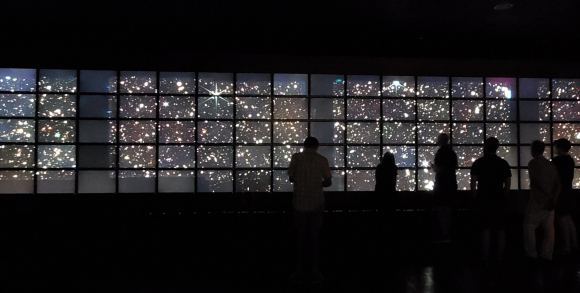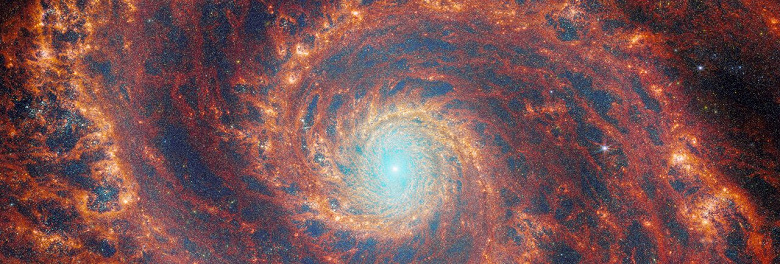JWST sheds light on the evolution of spiral galaxies at high redshifts
For many years before the launch of the «James Webb Space Telescope» (JWST) astronomers' efforts to study the structure and evolution of the early universe have been hampered by — extreme redshift of light from the earliest galaxies. The light from these ancient objects was so stretched due to the expansion of the Universe that it was shifted far into the red region of the spectrum, becoming virtually inaccessible to observation using optical and ultraviolet telescopes.
Unlike previous observatories, JWST was specifically designed to operate in the infrared, allowing it to effectively observe super-red-shifted objects. Once this telescope was commissioned and it activated its segmented beryllium primary mirror, astronomers were able to see for the first time the oldest red-shifted radiation in the Universe.
The light emitted by the first galaxies was not only extremely weak, but also underwent enormous stretching over billions of years of cosmic expansion. Such early galaxies, whose radiation reaches us in a highly reddened form, are called high-redshift objects, denoted z. Only infrared telescopes like JWST can detect and study such sources.
Data obtained by JWST have already allowed scientists to draw important conclusions about the early evolution of galaxies. It turned out that galaxies increased in size mainly due to mergers and collisions, and up to 60% of all galaxies currently have a spiral structure. Understanding the formation process of spiral galaxies is important because intense star formation occurs in their arms, during which heavy chemical elements are synthesized, necessary for the formation of rocky planets and ultimately — life.
One of the key scientific areas implemented with the help of JWST is called CEERS (Cosmic Evolution Early Release Science). As part of this program, the telescope has already obtained the first images of galaxies that existed at very early stages of cosmic history, when the Universe was only 500-700 million years old. Among other discoveries, CEERS discovered the most distant active supermassive black hole. These data will allow astronomers to make significant progress in understanding the key stages of the evolution of galaxies and the formation of their modern structure.
A recent study published in The Astrophysical Journal Letters has advanced the understanding of the early evolution of galaxies through data. The work, entitled «JWST, shows a surprisingly high proportion of spiral galaxies at 0.5≤ z≤ 4», was carried out by a team of scientists led by graduate student Vicki Kuhn from the University of Missouri.
«It was previously believed that most spiral galaxies appeared only 6-7 billion years after the birth of the Universe. However, our results suggest that spiral galaxies were already common around 2 billion years after the Big Bang. This means that the process of galaxy formation proceeded much faster than previously thought, — comments Yicheng Guo, assistant professor of physics and astronomy at Mizzou and co-author of the study.
The authors analyzed 873 galaxies from the CEERS observing program, belonging to the redshift range 0.5 ≤ z≤ 4 and having stellar masses of no more than 10 billion solar masses. They found that 216 of these objects had a spiral structure. «This proportion of spiral galaxies turned out to be surprisingly high, which indicates an earlier formation of spiral arms and disks in the Universe», — researchers note.
Determining the time frame in which spiral galaxies formed has long been an important question in astronomy, as it helps us better understand the overall evolution of the Universe. There are many theoretical models for how spiral arms might form, but the formation mechanisms likely differ for different types of spiral galaxies. New data allows us to better compare the physical characteristics of galaxies with theoretical concepts, complementing the overall picture of cosmic chronology, — says lead author Vicki Kuhn.
According to the concept outlined in the article, spiral galaxies are initially formed from gaseous disks. The results of this study, together with other observations of galaxies at high redshifts, paint the following picture of evolution: dynamically hot gas disks appear already at z = 4-5, then stabilize and become dynamically cold at z = 3-4. Since star formation occurs as gas cools and contracts, a large number of dynamically cool stellar disks with distinct spiral arms form during this period, z = 3-4.

The study also sheds light on the connection between spiral structures and other subsystems of galaxies. Gas-rich disks at high redshifts are highly turbulent, and gravitational instability leads to the formation of massive star clusters. Later, hot young stars speed up the rotation of galaxies, allowing them to calm down and become less turbulent. These regions of active star formation may also merge, further stabilizing the disks. Thus, the authors conclude that it is gravitational instability that is the primary cause of the emergence of spiral arms, while the role of star clusters is secondary, since they coexist with spirals in the early stages.
The researchers note some limitations to their work. Thus, merging galaxies can visually resemble spirals, and the long “tails” characteristic of mergers can be mistaken for spiral arms. In addition, at high redshifts z > 2, the proportion of galaxy mergers is considered higher, which adds additional uncertainty. However, the authors are confident that these factors did not greatly influence the overall conclusion: «The observed fraction of spiral galaxies decreases with increasing redshift – from ~43% at z = 1 to ~4% at z = 3. Thus , although spirals become rarer in the earlier Universe, their number still turns out to be significantly greater than previously thought».
«Spiral structure — a fundamental feature of galaxies that is used by astronomers to classify them and understand their evolutionary processes. Although we still have many questions about the past of the Universe, the analysis of these data obtained by JWST significantly advances our understanding of the early stages of the formation and development of galactic systems, — summarizes Yicheng Guo.

